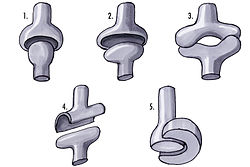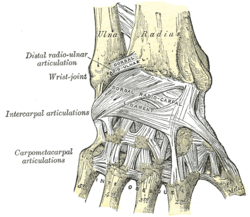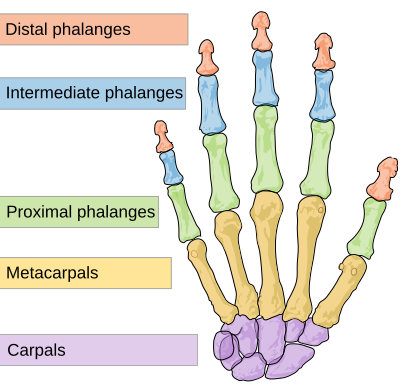(중략)
III. Anatomy of the Hand
...
The metacarpal{손바닥, 손허리} bones connect to two rows of small carpal{손목} bones in the wrist. There are eight carpal bones tightly connected by ligaments. We cannot move the carpal bones separately. Most of our wrist movement is at the joint between the carpal and metacarpal bones.
Move your wrist where it connects to the hand. Bending the wrist downward toward the forearm is called flexion. Curling the fingers is flexion of the fingers. Extending the wrist or fingers is called extension. Extension of the wrist is bending it upward.
The wrist joint (technically called the carpo-metacarpal joint) is capable of both flexion and extension. It will extend over a greater angle than it will flex. There is also some lateral movement. This kind of curved joint which allows some movement in all directions is called a saddle joint(안장관절, 안상관절).
Now spread your fingers as widely possible. There is some free play at the knuckle joints of the finger bones. These are saddle joints.
Joints that permit movement in only one plane are called hinge joints(경첩관절, 접번관절).
.... Below your thumb is a muscular pad covered with a layer of fat. Another muscular pad is found in the heel of the hand below the little finger. These pads have scientific names, but we will skip these. The middle of the palm is thinner and lacks large muscles. It too is cushioned with fat. The fat cushion of the palm helps in gripping objects. When you hold something tightly in your hand, the cushion of the palm and pads of the curled fingers spread and engulf the object like an amoeba. Sweat glands are numerous in the palm. The cushion grip, friction ridges, and moisture all work together to make the grip stronger.
... The muscle – actually a bundle of several muscles – below the thumb helps to move the thumb much more freely than the other fingers. It can be extended to the "thumbs up" position. It can also swing like a gate toward the palm and touch any of the other fingers. That is why our thumb is called an opposable thumb; it is separate from the other fingers and can freely close in on them.
The muscle mass below the thumb combined with a a saddle joint where the thumb and its metacarpal bone attaches to the carpal bones allow this range of movement. They also give the thumb the strength to apply strong pressure (as in pinching your little brother).
... Most people find that their thumb is the most mobile and agile. Next are the forefinger and the little finger. Then comes the middle finger. The stiffest and clumsiest finger is usually the ring finger. It could be called the "toe finger" because it has no more mobility than a toe.
The inside fingers are hardest to control because they have fewer muscles attached to them, not because their joints have less range of movement.
People who engage in repetitive activity with their hands, such as performing the same task on an assembly line, may come down with tunnel carpal syndrome. This condition causes the fingers or hand to itch or burn, or become numb....
V. Evolution of the Hand
A. The Primate Hand
Nearly all primates have a hand adapted for climbing and grasping. Many have an opposable thumb, which makes it possible to pick up food and other objects. Mammals, in general, shove their mouths directly into the food, whether it is vegetation or the carcass of a fresh kill. Primates, however, seize food with their hands and bring it to the mouth.
The primate genetically the nearest to humans is the chimpanzee. The human and chimp lineages are thought to have separated 5 – 7 million years ago. The next transparency shows the chimp hand.
The fingers are longer than ours and the thumb is shorter. The muscles that control the thumb are smaller in the chimp hand, so that its grip is weaker than in the human hand.
Chimps can only touch the middle of the other fingers with their thumbs. They use tools, such as fishing with a stick in termite mounds and cracking nuts with stones. But they lack fine motor control. No matter how intelligent a chimp might be, it cannot thread a needle nor get a tight grip on a baseball bat.
Preservation of fossil hand bones of our hominid ancestors is rare. The fossils that do exist suggest that the human hand evolved gradually into its present form. The critical step must have been when the early hominids became bipedal ground dwellers. This freed the hands to specialize in grasping and manipulating things. Crudely shaped stones used by early hominids for pounding are sometimes found near skeletal remains. This indicates that the thumb was acquiring the muscle strength and dexterity to aim the stone and hold it steady.
B. Kinds of Grip
- When you picked up a large cylindrical object, such as a can or bottle, you are using what is called the "power grip." The cushion of the palm fits tightly against the object, the four fingers curl around it in one direction, and the thumb hooks around in the other direction. With this grip you can squeeze the object and hold it very firmly. We use the power grip to pound with a hammer, swing a baseball bat, and hold a jar of peanut butter while unscrewing the cap with the other hand.
- The grip used to pick up a coin is called the "precision grip." The hand acts like a vise or clamp in the power grip. In the precision grip the tip of the thumb closes on the tip of the forefinger or middle finger like the jaws of a pair of pliers or the prongs of a pair of forceps. Fine control, not power, is the name of the game. See the transparency that shows both the power grip and the precision grip. Early hominids used the precision grip to make tools and to glean and pick fruits, seeds, nuts, and insect grubs that made up a large part of their diet.
- Some biologists believe that there is a third important grip. It can be called, for lack of a better name, the "chuck-grip." Flex your palm and bring your thumb against the tips of the four fingers of the hand. If you look directly at your fingers in this position, you will see that the arrangement resembles the jaws of a drill chuck. When you hold a roughly spherical object like a stone – or a baseball – your fingers and thumb are spread around the object in a chuck grip. Early hominids probably used the chuck grip to throw stones at predators, prey, and rival groups of hominids.
There are at least two hypotheses that try to explain the evolution of the hand in its present form. According to one hypothesis, our strong opposable thumb and improved motor control evolved to increase the hunting efficiency of males.
A strong power grip is needed to hold a club. Making a spear requires a precision grip, and to throw it any distance requires a modified power grip. To throw a stone far and accurately requires a chuck-grip.
According to an alternative hypothesis, the driving force in the evolution of the hand was increased efficiency in gleaning and gathering. It is thought that while the male hominids were out hunting, scavenging, and partying, the women were bending their backs gathering grubs and insects, seeds, and so forth. Although individual items had only limited caloric value, the total of a day's gleaning may well have contributed the bulk of the calories for a family.
Without tools, only the bugs, grubs, and parts of plants above ground would be available as food. These items would be equally available to other grazing and omnivore species. However, when early female hominids began to make crude digging sticks, and later more sophisticated ones with pointed tips, it became possible to harvest burrowing creatures and the storage tubers and roots of edible plants. In this way a rich new food source was opened up that was mostly untapped by other species. In order to make ever more efficient digging implements, a strong power grip and precison grip would have to evolve.
Which hypothesis is correct? No one knows for sure. Both may be partly right, and other, unknown, factors may have also played a role in the evolution of the remarkable appendages that you see sprouting from the ends of your arms.


.jpg)















